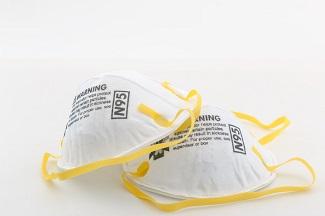How Providers Can Prevent Medical Device-Related Pressure Injuries Caused by Wearing Personal Protective Equipment
May 31, 2020
By the WoundSource Editors The World Health Organization declared COVID-19 a pandemic on March 11, 2020. Whether you are a provider or a frontline health care professional, we are experiencing a worldwide increase in “unavoidable” medical device–related pressure injuries (MDRPIs) during the current COVID-19 pandemic. Health care workers are challenged with a higher risk of pressure injury development secondary to prolonged wear time of the N95 mask, face shield, and goggle personal protective equipment (PPE).1,2 The intensity of one or more factors of pressure, moisture, shear, and friction influence pressure injury risk. Health care professionals are working longer hours because of short staffing issues and an increased number of patients with complex cases. Evidence-based standards of care are the same, but given the strain of the pandemic, we must bolster preventative education and practices. There are various worldwide organizations with recommendations on preventing and/or treating MDRPIs. The European Wound Management Association (EWMA), Nurses Specializing in Wound, Ostomy and Continence Canada (NSWOCC), Wound, Ostomy and Continence Nursing Society (WOCN), National Pressure Injury Advisory Panel (NPIAP), and National Health Service United Kingdom (NHS UK) all have guidelines for preventing these injuries.
Skin Care and Protection
The goal should be to prevent skin breakdown to facial areas prone to injury. Consistent skin and preventative regimens are warranted to eliminate risks of MDRPIs.
There are various factors to consider when selecting a dressing indicated to pad and protect facial areas at high risk of injury. Location and wear time are most important for PPE selection. The bridge of the nose, ears, forehead, and cheekbones are most prone to injury as a result of extended wear time of respirator masks. It is important to follow your facility’s infection control policy along with the recommendations provided here:
- Cleanse and hydrate skin 30 minutes before mask application.3 Gentle facial cleansing with a pH-balanced cleanser is encouraged. Avoid alkaline cleansers.2 Avoid petrolatum and mineral oil.2
- Apply an alcohol-free skin barrier or liquid sealant to high-risk pressure and friction points. Allow to dry.2,4
- If using additional protection beneath N95 mask, cut to fit using a thin, conformable adhesive-type dressing (e.g., thin hydrocolloid).3 Be sure to follow product guidelines.
- Remove mask for 15 minutes every two hours outside of patient contact areas, OR lift mask for five minutes every two hours.2
- Injured skin such as superficial abrasions should be treated with one of the following: moisturizer, alcohol-free skin sealant, and a low-profile dressing. Cyanoacrylate can be used but not near the eyes or mouth.2
Proper N95 Mask Fitting
Correct “donning and doffing” procedures are imperative for reducing the risk of MDRPIs. The Fit test should include checking for discomfort, redness, and soreness and adjusting to the correct fit. Low-profile dressings can be used under the N95 mask if they do not impair mask function. It is critical that dressings do not alter the seal of the N95 mask. Be sure to close your eyes and avoid inhaling during mask removal.
Conclusion
Prevention is key. Evidence-based practices for prevention of pressure injuries have been in place, but now health care workers are experiencing “unavoidable” injuries in a time of crisis. We must collaborate, educate, prevent, monitor, report, and evaluate to ensure consistency of reduced risks of pressure injuries. Thank you to ALL the health care professionals who are working endless hours for our patients. Remember to take care of YOU, too.
References 1. Padula CA, Paradis H, Goodwin R, Lynch J, Hegerich-Bartula D. Prevention of medical device-related pressure injuries associated with respiratory equipment use in a critical care unit. A quality improvement project. J Wound Ostomy Continence Nurs. 2017;44(2):138-141. 2. Protecting facial skin under PPE N95 face masks. The National Pressure Injury Advisory Panel PIP during the COVID-19 crisis. 2020. https://cdn.ymaws.com/npiap.com/resource/resmgr/position_statements/NPI…. Accessed May 18, 2020. 3. Guidance and supply on use of personal protective equipment (PPE) and other supplies. NHS England and NHS Improvement Coronavirus. March 20, 2020; updated April 12, 2020. https://www.england.nhs.uk/coronavirus/publication/guidance-supply-use-…. Accessed May 18, 2020. 4. Prevention and management of skin damage related to personal protective equipment (PPE). Nurses Specializing in Wound, Ostomy and Continence Canada. http://nswoc.ca/ppe/. Accessed May 18, 2020. 5. NPIAP position statements on preventing injury with N95 masks. The National Pressure Injury Advisory Panel PIP during the COVID-19 crisis. 2020. https://cdn.ymaws.com/npiap.com/resource/resmgr/position_statements/Mas…. Accessed May 18, 2020.
The views and opinions expressed in this blog are solely those of the author, and do not represent the views of WoundSource, HMP Global, its affiliates, or subsidiary companies.









Follow WoundSource
Tweets by WoundSource